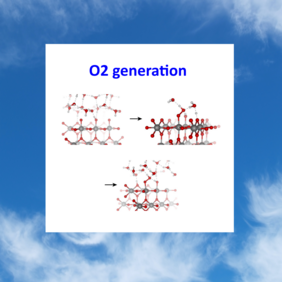Key role of chemistry versus bias in electrocatalytic oxygen evolution
Hong Nhan Nong, Lorenz J. Falling, Arno Bergmann, Malte Klingenhof, Hoang Phi Tran, Camillo Spöri, Rik Mom, Janis Timoshenko, Guido Zichittella, Axel Knop-Gericke, Simone Piccinin, Javier Pérez-Ramírez, Beatriz Roldan Cuenya, Robert Schlögl, Peter Strasser, Detre Teschner and Travis E. Jones
An interdisciplinary team of researchers from Technical University Berlin, Fritz-Haber-Institute Berlin, Max-Planck-Institute for Chemical Energy Conversion Mühlheim, ETH Zurich and Istituto Officina dei Materiali Trieste featuring also the UniSysCat groups of Beatriz Roldan Cuenya, Robert Schlögl and Peter Strasser gained new insights into the oxygen evolution reaction employing electrocatalysis.
The oxygen evolution reaction plays an important role in many alternative-energy schemes because it supplies the protons and electrons required for converting renewable electricity into chemical fuels. Employing electrocatalysis accelerates the reaction: electrocatalysts facilitate the required electron transfer as well as the formation and rupture of chemical bonds. This involvement of the electrocatalysts in fundamentally different processes results in complex electrochemical kinetics that can be challenging to understand and control.
In their article, Nong et al. report pulse voltammetry and operando X-ray absorption spectroscopy measurements on iridium oxide. They show that the applied bias does not act directly on the reaction coordinate, but affects the electrocatalytically generated current through charge accumulation in the catalyst. Further, it was shown that the activation free energy decreases linearly with the amount of oxidative charge stored. This relationship is related to the electrocatalytic performance and can be evaluated using measurement and computation.
Their demonstration how inner-sphere chemistry controls electrocatalytic oxygen evolution reaction rates establishes a fundamental link between thermal catalysis and electrocatalysis enabling the application of tools and concepts of traditional catalysis to electrocatalysis. For example, the linear activation free-energy relationships mediating catalytic rates can be measured and computed for understanding and improving electrocatalysis. Nong et al. anticipate that their fndings and methodology will help to better understand other electrocatalytic materials and design systems with improved performance.
The article has been published in Nature: Hong Nhan Nong, Lorenz J. Falling, Arno Bergmann, Malte Klingenhof, Hoang Phi Tran, Camillo Spöri, Rik Mom, Janis Timoshenko, Guido Zichittella, Axel Knop-Gericke, Simone Piccinin, Javier Pérez-Ramírez, Beatriz Roldan Cuenya, Robert Schlögl, Peter Strasser, Detre Teschner and Travis E. Jones (2020) “Key role of chemistry versus bias in electrocatalytic oxygen evolution”, Nature 587, 408-413, DOI: 10.1038/s41586-020-2908-2



